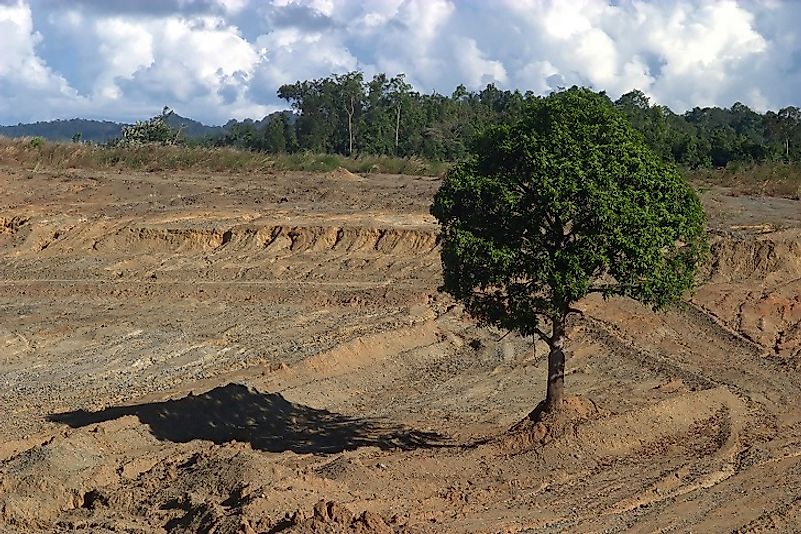15 Countries With The Worst Environmental Sustainability CPIA Ratings

Environmental sustainability is how organizations and governments look to an ideal that could create sustainable development and achieve the ideal. These ideals could be towards a healthy ecosystem and environments. The other is sustainable economic growth that depends on renewable resource. However, environmental sustainability today is dependent on policies and production that is environmentally degrading.
Human impact is the deciding factor that limits environmental sustainability in all its aspects. There should be positive measures in the form of policies, laws, urban planning, and transport. Living conditions, lifestyle changes, and ethical consumerism that lead to the conservation of our natural resources are critical factors for future success.
Failed Environmental Sustainability
Many factors contribute to failed environmental sustainability. Governments look to achieve a positive environmental sustainability record but people and the economy are given first priority. These factors are: population growth, food security, overconsumption, economic growth, environmental degradation, and climate change. Concentrated in Sub-Saharan Africa, are countries whose environmental sustainability policies have achieved zero progress.
The Worst Countries Assessed
According to the Country Policy and Institutional Assessment (CPIA) data of the World Bank, these countries have the worst environmental sustainability records. Scores are from 1 (worst) to 6 (best).
- The number one worst country is Central African Republic (2.0). The 2012 conflict deterred the success of planned economic and social development projects in the country that would have brought basic services and infrastructure to rural areas.
- Number two is Papua New Guinea (2.0). Rural folks remain dependent on subsistence agriculture. Logging, destructive fishing, mining operations, and land degradation also add to the problem.
- Number three is Eritrea (2.0). Causes are erosion, deforestation, desertification, land loss with land mines, and overgrazing.
- Number four is South Sudan (2). Causes are logging, water pollution, oil drilling, wars, and overfishing.
- Number five is Sudan (2.0). Causes are tribal conflicts, deforestation, logging, desertification, and poverty.
- Number six is East Timor (2.0). Causes are Deforestation, desertification, dredging, effluents, and dam-building.
- Number seven is Djibouti (2.5). Causes are desertification, deforestation, water pollution, and logging.
- Number eight is Chad (2.5). Causes are effluents, potable water, poor farming techniques, water pollution, and desertification.
- Number nine is the Democratic Republic of the Congo (2.5). Causes are water pollution, deforestation, refugee activities contributing to deforestation, soil erosion, poaching, and mining.
- Number ten is Guinea-Bissau (2.5). Causes are soil erosion, overgrazing, overfishing, and deforestation.
- Number eleven is Myanmar (2.5). Causes are industrial pollution, inadequate sanitation, water treatment, and deforestation.
- Number twelve is Sri Lanka (2.5). Causes are poaching, urbanization, deforestation, pollution, and effluents.
- Number thirteen is the Solomon Islands (2.5). Causes are coral bleaching, deforestation, soil erosion, and defoliants.
- Number fourteen is Kyrgyzstan (2.5). Causes are potable water, soil salinity, water-borne diseases, and water pollution.
- Number fifteen is Haiti (2.5). Causes are soil erosion, potable water, deforestation, and logging.
Environmental Relationships
American political theorist and writer, Murray Bookchin, wrote that governments have the capacity and already have exploited nature and natural resources as a mere commodity. He added that all of the present ecological problems had their origin in dysfunctional social arrangements. Bookchin further posited that the solution may be in understanding the underlying social processes and use the social sciences to create a solution to these problems.
Swedish scientist Karl-Henrik Robert developed The Natural Step Framework in 1987 in promoting its principles of sustainability of human activities on earth. According to Robert, the dependence on metals, minerals, and fossil fuels should be reduced, and the same for unnatural substances and synthetic chemicals. A lessened encroachment on nature and a fair and efficient way to meet human needs must find a happy medium.
15 Countries With The Worst Environmental Sustainability CPIA Ratings
| Rank | Country | CPIA Environmental Sustainability Score, 1=Worst, 6=Best |
|---|---|---|
| 1 | Central African Republic | 2.0 |
| 2 | Papua New Guinea | 2.0 |
| 3 | Eritrea | 2.0 |
| 4 | South Sudan | 2.0 |
| 5 | Sudan | 2.0 |
| 6 | East Timor | 2.0 |
| 7 | Djibouti | 2.5 |
| 8 | Chad | 2.5 |
| 9 | DR Congo | 2.5 |
| 10 | Guinea-Bissau | 2.5 |
| 11 | Myanmar | 2.5 |
| 12 | Sri Lanka | 2.5 |
| 13 | Solomon Islands | 2.5 |
| 14 | Kyrgyzstan | 2.5 |
| 15 | Haiti | 2.5 |











